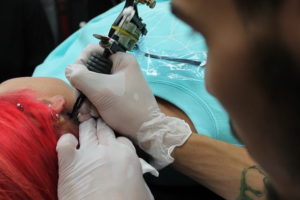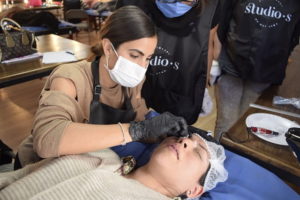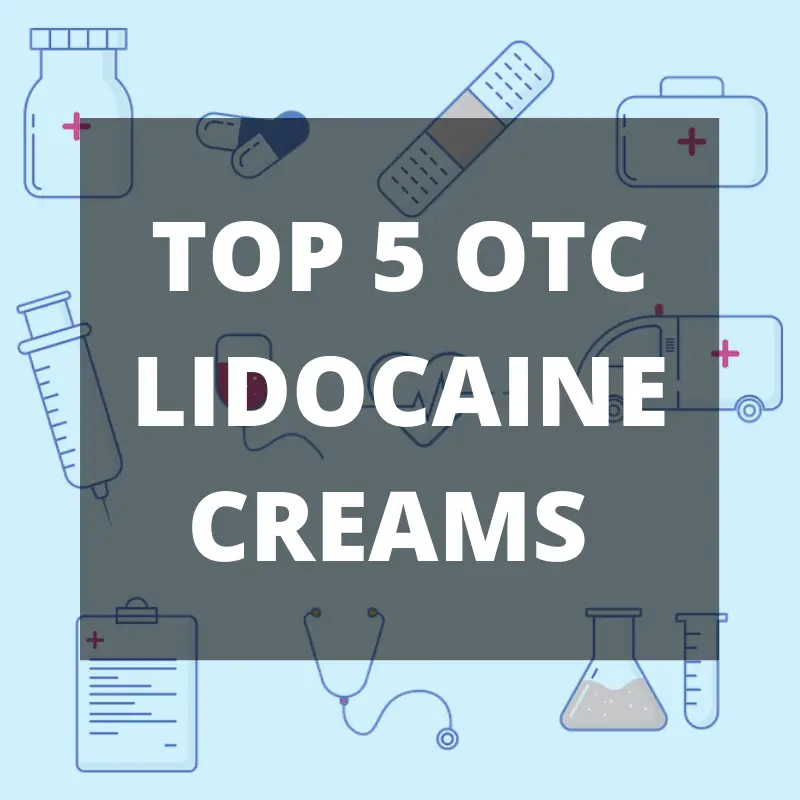Strongest OTC Lidocaine Creams

As people age, random pain and aches become a norm for daily life. Some people use prescription medications for relief and others turn to less potent alternatives such as creams and ointments to achieve the same effects. One of these alternatives is lidocaine cream which can be purchased over the counter.
Lidocaine creams are one of the most popular pain-relieving and numbing medications that people use. People use them for general pain relief, getting a tattoo, waxing, microblading, minor cuts, sunburns, hemorrhoids, poison oak, poison ivy, and other skin irritations.
No matter the reason for using lidocaine, there is something you should know. Not every lidocaine cream bought over-the-counter are built the same and often vary in concentration and purpose. For example, some are better for general pain relief while others are ideal for waxing.
You should always consult with your doctor or medical professional before using lidocaine cream or general anesthetic.
Here is a list of the best lidocaine creams on the market:
- LMX 4 Topical Anesthetic Cream – Best All-Around
- Zensa Numbing Cream – One of the Strongest OTC Lidocaine Creams
- Ebanel 5% Lidocaine Cream – Fastest Acting Lidocaine Cream
- Hush Numbing Gel – Preferred for tattoos
- Deeveeant Numb – Ideal for Microblading and Waxing
1. LMX 4 Topical Anesthetic Cream
LMX 4 Topical Anesthetic Cream is not the strongest lidocaine cream on the market but does contain 4% which is more than enough for laser treatments, general pain, minor burns, scratches, and even injections. The reason this lidocaine cream is the best all-around is due to how versatile this product is.
This product has been reported to reduce pain experienced by 75% from laser treatments, skin tag removals, and even sunburns. If you are experiencing pain from any of these or even pain from poison oak, poison ivy, poison oak sumac then this can significantly reduce your pain.
Key Benefits:
- Great for laser treatments and injections
- 4% lidocaine can numb most general pain
- Can be applied 4 times a day which allows a lot of use
2. Zensa Numbing Cream
Zensa Numbing Cream is one of the best and strongest numbing creams on the market. The only reason it did not get the number one spot is because not everyone needs a lidocaine cream that is this strong. Zensa contains the maximum amount of lidocaine legally allowed to be sold over the counter which is 5% lidocaine.
Zensa is an FDA approved product that provides pain relief within minutes. It is fast-acting and people have reported it working within minutes. This product provides pain relief for 2-4 hours and with reapplication, this can be extended to 6-8 hours.
Honestly, the fact that this works so quickly to provide pain relief for an extended period of time is the reason that it is highly recommended by cosmetic, tattoo, and beauty professionals. We recommend people who need strong pain relief for an extended period of time to use Zensa.
Key Benefits:
- Long-lasting pain relief (Up to 6-8 hours with reapplication)
- 5% lidocaine (maximum strength) relieving some of the worse pain
- Fast absorbing
- Recommended for people experiencing long periods of pain
3. Ebanel 5% Lidocaine Cream
Ebanel 5% has been dubbed by us as one of the fastest acting lidocaine cream because it starts working within 2-3 minutes. This ointment will peak in strength around 20-25 minutes and will last about an hour after the peak.
Not only does it work fast but it is also really strong. Like Zensa, it contains 5% lidocaine which makes it one of the strongest on the market. Ebanel is also created in an FDA registered facility to ensure the quality of the product. This product is ideal for people that need quick and powerful pain relief.
Key Benefits:
- Best for someone who needs quick pain relief
- 5% lidocaine is able to desensitize most pain
- Works within 2-3 minutes.
4. Hush Numbing Gel
Hush Numbing Gel is one of the best lidocaine creams for people looking for pain relief from getting a tattoo. There are not many numbing gels quite like this one on the market. This one is specifically designed to numb the skin for tattoos.
It’s maximum strength meaning it contains 5% lidocaine which is great to absorb and numb the dermis instead of just the top layer of skin. This deeper absorption allows tattoo sessions to become a breeze. Also, the formulation does not warp the ink which is ideal for tattoos.
Hush also lasts up to 2 hours, with users reporting effects even longer than this. People getting tattooed in the most painful places have used Hush and reported feeling nothing. If you have a tattoo session coming up, you may want to try this one.
Key Benefits:
- Recommended for tattoo sessions
- 5% lidocaine provides great pain relief
- Vegan and cruelty-free
5. Deeveeant Numb
One of the most popular lidocaine creams for microblading, microneedling, and waxing right now is Deeveeant Numb. This cream is 4% lidocaine which is strong enough for most microblading, waxing, and microneedling sessions depending on your pain thresholds.
The formulation also contains aloe vera, jojoba, and tea tree oil which aids with skin inflammation. So, not only do you get the numbing effects but also something to reduce inflammation of the skin.
You can expect this product to last
Key Benefits:
- Best for waxing, microblading, and laser treatments
- Helps reduce inflammation
- 4% lidocaine will desensitize most waxing and microblading sessions
How to Apply Over-the-Counter Lidocaine Cream
If you plan on using lidocaine for tattoos, waxing, microblading, or just general pain relief then you will want to know the most effective way to use it. Using and handling this product properly can be the difference between sitting in discomfort or being pain-free.
But the truth is, applying lidocaine cream will depend on what you need the numbing effect for. For example, a person using lidocaine for back pain relief will use it differently than a person preparing for a tattoo session.
Always consult with a medical professional or your doctor before introducing a new treatment to your body. This website does not provide medical advice.
Prepare the Application Site
Clean the application site or place you would like to apply lidocaine cream with warm water and mild soap. Then dry the skin by lightly patting with a towel.
It is important to cleanse the skin to help maximize the numbing effect of the lidocaine cream and prevent any other unintended reactions.
Removal of any dirt or other containments off of the skin will help reduce the possibility of anything conflicting with the effectiveness of the lidocaine.
Test Your Body’s Reaction
As aforementioned, we recommend that you must consult with a doctor before introducing any new medication or treatment. We cannot stress this enough.
After consulting with your medical professional, it is recommended to test your body’s response to lidocaine by performing an allergy test. Apply a small amount of lidocaine to the application site using a q-tip or cotton ball.
This allergy test will also test to see how effective lidocaine is to your body.
Similar to lidocaine products, not everyone is made the same and often have different experiences with lidocaine. It has been reported that lidocaine may not work effectively for everyone since people have slightly different body compositions and chemistry.
After applying to the test site, wait a few minutes to see if you have any type of allergic reaction to it. If you do, seek medical attention immediately.
If you do not experience an adverse effect or reaction, you can now be reasonably certain that lidocaine works well with your body. We recommend confirming with your doctor or medical professional.
Apply the Cream
After testing your body’s response to lidocaine, it is time to apply it. Use gloves, cotton balls, q-tips, or a cloth to apply lidocaine topically to the needed location. Numbness from the cream is expected within 5 minutes but can vary depending on the product.
Numbness typically reaches full effect within 20-30 minutes and should last for an hour or longer depending on the strength of the product.
If you feel that the numbing effect is starting to dissipate then you may want to reapply a second coat. Follow the same instructions above and on the product box for applying the second layer of lidocaine cream. Depending on the product, it may have different instructions for applying a second coat.
If your treatment is over, you can remove any excess cream using warm water, soap, and a washcloth. Ensure that the cream is completely removed from your skin and be sure to wash your hands after.
How Long Does Lidocaine Cream Last?
Now that you know how to apply your lidocaine cream, the next question you may have is how often do I need to reapply it?
Most lidocaine creams purchased over-the-counter last for an hour. Some have been reported to last even longer up to 4 hours depending on how you apply the product and the strength.
Everyone’s body reacts differently. Some people may experience that lidocaine will last less than an hour while others report it lasting for 6 hours. It honestly just depends on how your body handles the product.
What Does Lidocaine Work Best For?
Lidocaine cream has a ton of different uses but it is most commonly used for back pain, getting tattoos, waxing, and general pain. But as humans, we all have one thing in common: we hate pain and discomfort.
Pain thresholds vary from person to person due to how our bodies react to stimuli. Some are more sensitive to others. Many people utilize lidocaine creams they purchase over the counter for their tattoo, waxing, and microblading sessions.
Lidocaine creams uses have surpassed just back pain. Here is a list of common uses people have reported using lidocaine cream:
- Tattoos
- Waxing
- Microblading
- Back pain
- General pain
- Sunburns
- Insect bites
Recommended: Do not get the product in your eyes, mouth or nose. If the medicine gets in these areas, immediately rinse it with clean water.
For Tattoos

There is a lot of expensive numbing creams on the market for tattoos, but one great alternative is using lidocaine cream. Lidocaine works amazingly for tattoo sessions because it deadens the nerve endings that are sending the signals of pain to the brain. It can also prevent any jarring or involuntary movements of your body caused by a tattoo needle striking a nerve.
Will Lidocaine Cream Ruin My Tattoo?
No, lidocaine cream will not mess up your tattoo. A lot of tattoo artists do not like using lidocaine cream because they believe if you are getting a tattoo, you should be able to bear the pain. Luckily, you don’t need their permission.
How to Use Lidocaine for Tattoos
Lidocaine can come in a cream or spray form and can range from 2% to 5% concentration. For a tattoo session, apply if 30 minutes before the time your session starts. Apply gloves or apply with a cotton ball to work the ointment in.
Once it has been rubbed in, it is best to rinse it off with soap and water. After cleaning the area, a lot of tattoo experts wrap the area with saran wrap for the half-hour leading up your session. Keep in mind, the duration of your product’s effects when planning your tattoo sessions.
For Waxing and Microblading

For most people, waxing can be a painful session that people often dread but go through it because they want the results. People tend to cope with these sessions by taking deep breaths or asking your esthetician to pace it.
But those days are over since now people are using topical skin numbing creams for waxing and microblading by applying lidocaine cream before their session. This desensitization of the area that you plan on getting waxed or microbladed will have you not dreading your sessions.
For Back Pain
Many people have turned to lidocaine for their back pain. Not long ago, a study done in 2002 tested the effectiveness of a lidocaine patch 5% for the treatment of patients with chronic lower back pain.
The results showed the lidocaine patch relieving varying characteristics of pain, including general pain, shooting pain, burning pain, and allodynia [1]. The lidocaine patch 5% had a significant impact on the quality of life of all patients in the study [2]. Some were able to reduce or altogether stop some medications [3]. No adverse events were reported from the lidocaine patch during the clinical study [4].
This study shows how effective and how much lidocaine cream or patches can improve a person’s quality of life. If you are suffering from back pain, check out one of Amazon’s best selling lidocaine patches for back pain.
Strongest Lidocaine Dosage Allowed Over-the-Counter
The strongest amount of lidocaine allowed over the counter in the United States is 5% and will keep your skin numb for an hour to ninety minutes.
Duration depends on your body’s composition and absorption rate. Remember, these are general estimations on how long you can expect the numbing effect to last.
Can Other Drugs Affect Lidocaine Cream?
Topically applying medicine is typically not affected by other drugs you use but other drugs may interact with it.
Tell your doctor or healthcare provider of any drugs, vitamins, supplements, medicines, and herbal products you use before starting a new treatment such as lidocaine cream.
What is Lidocaine?
Lidocaine is a numbing medication that is also called a local anesthetic. When used topically for the skin, the purpose of it is to reduce pain or discomfort caused by skin irritations which include minor cuts, scratches, burns, sunburn, poison ivy, poison oak, and insect bites. It works by blocking the nerve signals in your body.
How Does Lidocaine Cream Work?
In layman’s terms, lidocaine works blocking the nerve signals in your body, thus, offering pain relief. Lidocaine hydrochloride is known as a local anesthetic, meaning it temporarily numbs painful areas of the body.
Scientifically, it blocks the pain by blocking sodium from the nerve ending. Thus, preventing the brain from receiving the pain signal from the nerve fibers.
What You Must Know About Lidocaine Cream
Everyone has different absorption rates when it comes to topical lidocaine cream. These differences in absorption mean that people will experience very different effects and must take extreme precautions before using lidocaine cream.
If you plan on using lidocaine cream, you should contact your healthcare professional or doctor because everyone’s body handles and absorbs lidocaine differently. One person may have a reaction to it, so it’s highly advised and recommended to always contact your doctor before starting a new treatment.
Who Should Not Use Lidocaine Cream
We do not recommend if you are pregnant or breastfeeding to use lidocaine cream. But if you plan on using it, consult with your doctor before using lidocaine cream or any other medication.
Also, you should not use lidocaine cream if you are allergic to lidocaine or xylocaine or other local anesthetics.
Possible Side Effects
Similar to other topical treatments, there is a possibility of experiencing side-effects. One of the most common side effects of topical include itching, irritation, and redness of the skin at the application site.
With lidocaine cream, there can be more adverse side effects due to the fact the body absorbs it and everyone’s body is different from the amount of absorption. We always recommend consulting with your doctor before introducing any new treatment.
After you have received permission from a medical professional, apply a small amount of lidocaine as a reaction test before using a full amount recommended on the product label.
If you have any of the following side effects, contact your doctor or healthcare professional right away.
- Twitching or shaking
- Feeling hot, cold, or numb all over
- Blurred vision or seeing double
- Throwing up/vomiting suddenly
- Hearing a ringing noise
- Feeling lightheaded, dizzy, or sleepy
- Feeling nervous or confused
Warnings
Using excessive dosages or short intervals between doses can result in high plasma levels and serious adverse effects. If you are going to use lidocaine cream adhere to the recommended dosage and administration guidelines that are labeled on the package insert.
Lidocaine ointment should be used with extreme caution especially in the presence of sepsis or severely traumatized mucosa in the area of application. Under such conditions, there is the potential for rapid systemic absorption.
Our Verdict
Lidocaine cream is one of the most popular and effective topical pain relievers on the market. All over the world people are utilizing this cream to reduce pain for tattoos, waxing, and back pain.
In this article, we hope you learned about what lidocaine cream is, how it works, the different usages, and even some of the best products on the market place. Always exercise precaution when using lidocaine cream and consult with your doctor or healthcare professional.






